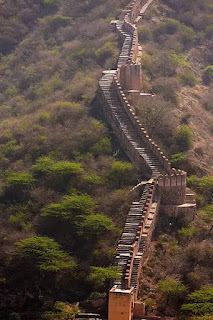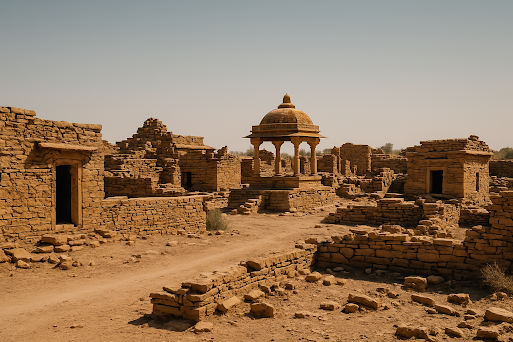🏰 Kumbhalgarh – The Great Wall of India and Pride of Mewar
Nestled in the rugged folds of the Aravalli Hills in Rajasthan, Kumbhalgarh stands tall as a timeless symbol of Rajput valor, architectural brilliance, and royal heritage. Known as the "Great Wall of India", this majestic fort is not just a fortress of stone but a narrative of power, refuge, and devotion. Whether you are a history enthusiast, a culture lover, or a curious traveler, Kumbhalgarh is an experience that stays with you long after your visit.
📍 Location and Significance:
-
Kumbhalgarh Fort is situated in the Rajsamand district of Rajasthan.
-
It lies approximately 84 km from Udaipur and 48 km from Rajsamand.
-
The fort is perched high in the westerly range of the Aravalli Hills, offering breathtaking panoramic views.
-
Built in the 15th century by Rana Kumbha, a celebrated ruler of Mewar.
-
Kumbhalgarh is famed for its 36-kilometer-long wall, making it one of the longest continuous walls in the world — second only to the Great Wall of China.
-
It also holds great historical value as the birthplace of Maharana Pratap, one of India’s most iconic Rajput warriors.
-
The fort’s location, scale, and heritage make it a crown jewel of Rajasthan’s architectural and cultural history.
🏰 A UNESCO World Heritage Site:
In 2013, at the 37th session of the UNESCO World Heritage Committee held in Phnom Penh, Kumbhalgarh Fort was declared a World Heritage Site as part of the Hill Forts of Rajasthan group — alongside Amber, Chittorgarh, Ranthambore, Gagron, and Jaisalmer forts. These forts collectively represent the finest examples of Rajput military hill architecture.
🧭 Etymology and Historical Background:
The name “Kumbhalgarh” is derived from Rana Kumbha, the ruler who built the fort, and "garh", meaning fort.
Rana Lakha first conquered the region in the 14th century, but it was Rana Kumbha who commissioned the construction of the grand fort in 1448 AD, under the guidance of his chief architect Mandan. Kumbhalgarh became a strategic and secure second capital for the Mewar kingdom.
🛡️ Historical Events:
-
The fort provided refuge to rulers of Mewar in times of conflict.
-
In 1535, infant Prince Udai Singh (future founder of Udaipur) was hidden here when Chittor was under siege.
-
It withstood numerous attacks, including those by Ahmad Shah II of Gujarat and Mahmud Khalji, but was never conquered in direct combat.
-
Mughal general Shahbaz Khan captured it after a six-month siege in 1578 but it was reclaimed by Maharana Pratap in 1583.
-
Later, in the 19th century, the British briefly took control before returning it to Udaipur State.
🏯 Architecture – Grandeur in Every Stone:
Built at 1,100 meters above sea level, Kumbhalgarh is a marvel of Rajput architecture.
🧱 Key Features:
-
Perimeter wall: 36 km long, 15 feet thick
-
Seven fortified gateways including Ram Pol, Hanuman Pol, Vijay Pol, and Ganesh Pol
-
Over 360 temples inside the fort (Hindu and Jain)
-
Badal Mahal (Palace of Clouds): Located at the highest point of the fort
From the palace top, visitors can enjoy sweeping views of the Aravalli Range, a view that's both mesmerizing and humbling.
🛕 Temples of Kumbhalgarh Fort: A Sacred Citadel
Verified by ASI & Rajasthan Archaeology Department
Kumbhalgarh Fort, a UNESCO World Heritage Site, isn't just a military marvel—it’s home to over 360 temples, echoing centuries of devotion, diversity, and artistic brilliance. The temples here reflect both Hindu and Jain traditions, coexisting peacefully within the fort’s mighty walls.
⛩️ Hindu Temples at Kumbhalgarh:
1. Ganesha Temple:
-
📍 Location: Just inside the Ram Pol gate (main entrance)
-
🐘 Highlights: Features rare elephant-head motifs carved into the ceiling beams.
2. Charbhuja Temple:
-
🕉️ Deity: Vishnu in his four-armed form ("Charbhuja")
-
🌀 Clarification: Not to be confused with Ambika Mata Temple (nearby and often misidentified).
3. Neelkanth Mahadev Temple:
-
🔱 Crowning Jewel: Houses a majestic 12-armed Shiva idol, 5.5 ft tall.
-
🧱 Material: Constructed from red sandstone and marble with intricate sculpting.
4. Mataji / Kheda Devi Temple:
-
🔮 Significance: Regarded as a Shakti Peetha, believed to spiritually guard the fort's western side.
-
📖 Folklore: Locals credit the temple for protecting the fort from repeated invasions.
5. Surya Mandir (Sun Temple):
-
☀️ Special Feature: Aligns with the equinox sun—sun rays enter directly on equinox mornings.
-
🛕 Carvings: Includes detailed sun chariot engravings.
6. Mamadeo Temple:
-
🎭 Style: Noted for rare erotic sculptures, a unique feature for a fort temple.
-
🏛️ Connection: Adjoins the chhatri of Kunwar Prithviraj (Mewar prince).
7. Golera Group (Hindu):
-
🔹 Details: Cluster of 5 temples—3 Vaishnavite, 2 Shaivite.
-
📆 Era: Built between 10th–12th century, predating the fort itself.
☸️ Jain Temples at Kumbhalgarh
1. Parsva Natha Temple (1513 CE):
-
✒️ Commissioned by: Jain merchant Jagdu Shah
-
🗿 Idol: Black marble statue of the 23rd Tirthankara, Parsvanatha
2. Bawan (52) Jain Temples:
-
🛐 Architecture: A unique collective shrine with 52 miniature sanctums.
-
📸 Uniqueness: Each small temple is dedicated to a different Tirthankara.
3. Vedi Temple (1457 CE):
-
🧘 Purpose: Built by Rana Kumbha for conducting royal yagnas.
-
🏺 Design: Elevated on a high platform with octagonal domes.
4. Golera Jain Group:
-
🏯 Temples: 4 Jain temples showcasing Dravidian-style shikharas.
-
🧾 Date: The oldest among them dates back to the 13th century.
5. Juna Bhilwara & Pital Shah Temples:
-
🔎 Tradition: Follow Digambara Jain philosophy.
-
🛠️ Status: Currently under ASI conservation for preservation.
📌 Additional Sacred Structures (Often Overlooked):
-
🏰 Kumbha Palace Temple:
-
Private royal shrine once adorned with gold-plated doors (now lost to time).
-
-
🚪 Hanuman Pol Temple:
-
Flanked the entrance gate; once had a 12-ft idol of Lord Hanuman guarding the fort.
-
🥁 Cultural Legacy and Festivities:
The Rajasthan Tourism Department organizes an annual three-day festival at Kumbhalgarh to honor Maharana Kumbha's passion for art and architecture. This celebration features:
-
Sound & light shows
-
Classical music and folk dance
-
Heritage walks
-
Cultural competitions like turban tying and mehendi mandana
This vibrant event brings the historic fort to life and connects modern audiences with Rajasthan's rich legacy.
🌄 Why Visit Kumbhalgarh?
Kumbhalgarh is not just a fort — it’s an epic saga in stone. Whether you are exploring its massive walls, marveling at centuries-old temples, or soaking in the panoramic vistas of the Aravallis, every corner of this fort has a story to tell.
It is a perfect weekend getaway from Udaipur, and a must-visit for anyone seeking heritage, serenity, and grandeur.
✨ Final Thoughts:
Kumbhalgarh is more than just a fort — it is a testament to the indomitable spirit of the Rajputs, a masterpiece of architecture, and a jewel in Rajasthan’s crown. Whether you're a history buff, an architecture admirer, or a traveler in search of stories, Kumbhalgarh awaits you with open gates and centuries of heritage.






Comments
Post a Comment